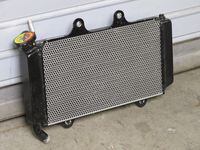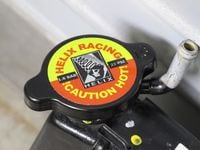WRIST: Ari Henning
MSRP: (2015): $5,499
MILES: 2,966
MPG: n/a
MODS: Helix Racing guard and cap
I've been sidelined with a holed radiator in the past, so I always put some form of protection on my bike's cooling array, especially if that bike is going to be raced. Sometimes the guard is a purpose-built piece like those offered by Cox Racing Group (see coxracinggroup.com) or a homemade one cut from hardware-store window screen, and other times it's something in the middle like this guard I cut from a sheet of aluminum mesh.
Helix Racing (see helixracingproducts.com) manufacturers sheets of this aluminum mesh specifically for making radiator and oil-cooler guards. It's easily cut with a pair of tin snips, and then you can use safety wire or zip ties to secure the guard to the radiator. I only used a small portion of the $45 18 x 18-inch sheet, so I have plenty left over for other bikes. I'll see if Zack wants one for his long-term Yamaha YZF-R1 ( follow Zack's R1 project here).
With those delicate cooling fins protected, I turned my attention to the radiator cap. Racers often install a high-pressure cap to boost the boiling point of the coolant and stave of cavitation (with greater system pressure comes a higher vapor pressure—remember high-school chemistry?), and since some street riders have reported that the stock 1.1-bar cap on the RC390 sometimes pops off on hot days, I figure this 1.6-bar, $20 cap is cheap insurance.
Both the radiator mesh and the radiator cap are manufactured by Helix Racing and sold through various retailers online. If you’re thinking about upgrading your cap, don’t be tempted to buy the highest-rated part you can find. The radiator cap is designed to be the weak link in the cooling-system chain, so stepping up the pressure rating of the cap too much means that something else in the system will have to let go, and that could be catastrophic. That’s only an issue if your bike is running really, really hot, so just keep an eye on your temperature gauge and don’t push your luck.











/cloudfront-us-east-1.images.arcpublishing.com/octane/RKL36S2YZNLXYTACTVLSBF5RAM.jpg)


/cloudfront-us-east-1.images.arcpublishing.com/octane/GTCXACQGJ5HAPDTGWUQKDEH44E.jpg)
/cloudfront-us-east-1.images.arcpublishing.com/octane/S35YGSEMEZB4BLTDJTSZPF4GLA.jpg)
/cloudfront-us-east-1.images.arcpublishing.com/octane/5UOT6HPX2JFMRJAX6EH45AR4MQ.jpg)
/cloudfront-us-east-1.images.arcpublishing.com/octane/OKWOJWAKP5EP3OACCRRWPCIX2Q.jpg)
/cloudfront-us-east-1.images.arcpublishing.com/octane/2WF3SCE3NFBQXLDNJM7KMXA45E.jpg)
/cloudfront-us-east-1.images.arcpublishing.com/octane/G4MG6OUCJNBSHIS2MVVOTPX65E.jpg)
/cloudfront-us-east-1.images.arcpublishing.com/octane/IIGGWFOTOJGB7DB6DGBXCCMTDY.jpg)
/cloudfront-us-east-1.images.arcpublishing.com/octane/QSTCM6AVEZA5JJBUXNIQ3DSOF4.jpg)
/cloudfront-us-east-1.images.arcpublishing.com/octane/U4I7G625B5DMLF2DVIJDFZVV6M.jpg)
/cloudfront-us-east-1.images.arcpublishing.com/octane/B6XD6LS6IVCQPIU6HXDJSM3FHY.jpg)
/cloudfront-us-east-1.images.arcpublishing.com/octane/ICL63FEDDRDTTMINYICCEYGMDA.jpg)
/cloudfront-us-east-1.images.arcpublishing.com/octane/FCGZHQXRBZFLBAPC5SDIQLVF4I.jpg)
/cloudfront-us-east-1.images.arcpublishing.com/octane/WNOB6LDOIFFHJKPSVIWDYUGOPM.jpg)

/cloudfront-us-east-1.images.arcpublishing.com/octane/X33NU3E525ECRHXLNUJN2FTRKI.jpg)
/cloudfront-us-east-1.images.arcpublishing.com/octane/6KKT5NNL2JAVBOXMZYS5ZO76YA.jpg)
/cloudfront-us-east-1.images.arcpublishing.com/octane/J5RKG5O455GMPGQRF2OG6LRT7A.jpg)
/cloudfront-us-east-1.images.arcpublishing.com/octane/GX2CIZKQVRH2TATDM26KFG2DAE.jpg)
/cloudfront-us-east-1.images.arcpublishing.com/octane/ZWIDYSAKQZHD5BHREMQILXJCGM.jpg)
/cloudfront-us-east-1.images.arcpublishing.com/octane/CYUHJZCTSJCH3MRAQEIKXK7SCQ.jpg)
/cloudfront-us-east-1.images.arcpublishing.com/octane/LKOFINY56FCXJCANJ5M7ZDQUBY.jpg)
/cloudfront-us-east-1.images.arcpublishing.com/octane/4NBPDACMWJH63JQYJVK3QRBDZI.jpg)
/cloudfront-us-east-1.images.arcpublishing.com/octane/KKHQHRR3FJGX7H2IPU6RALMWG4.jpg)
